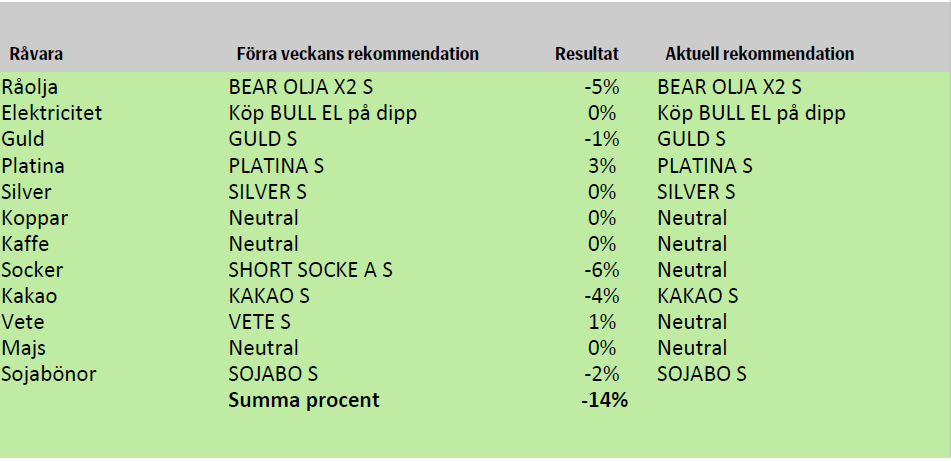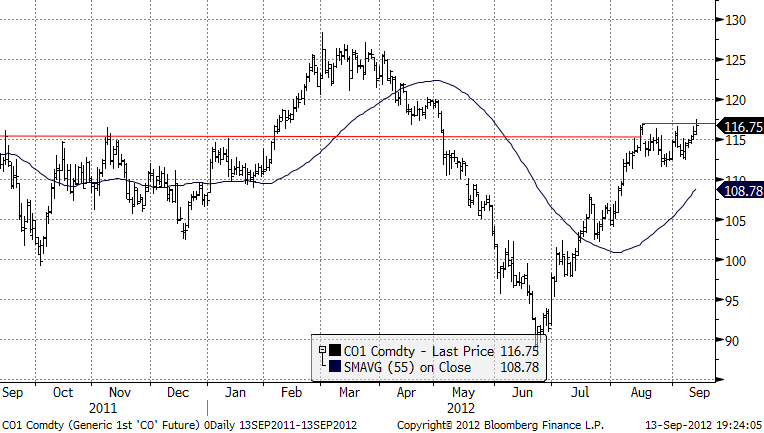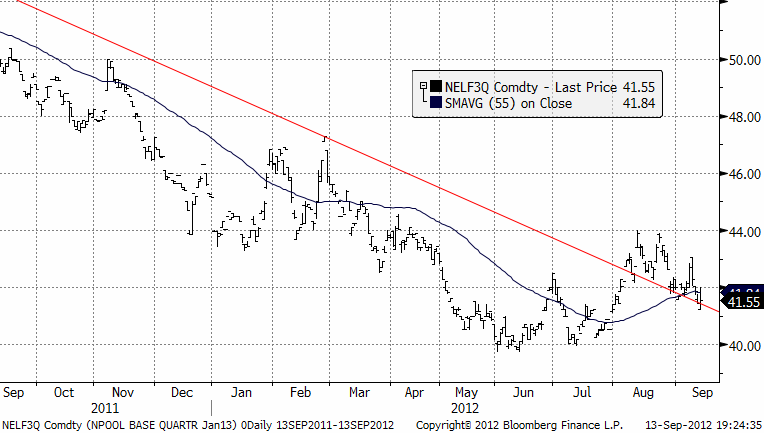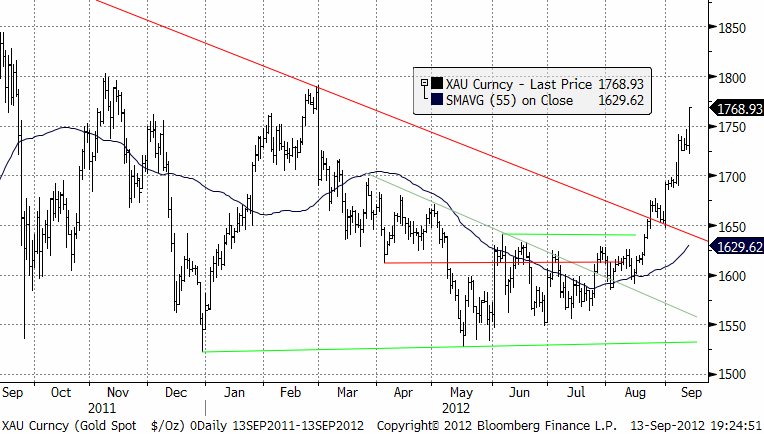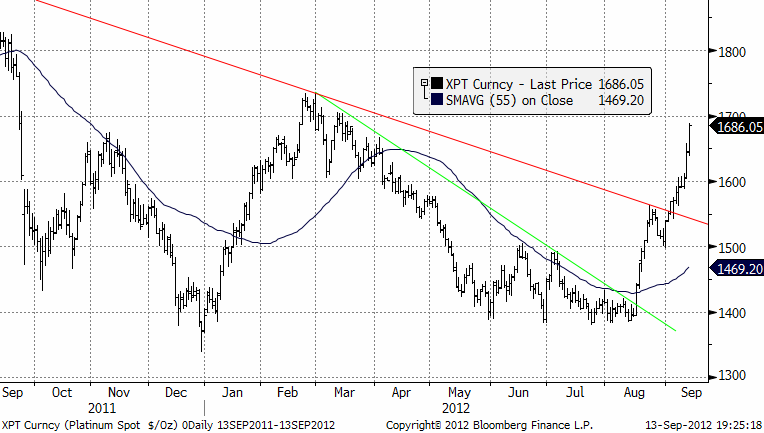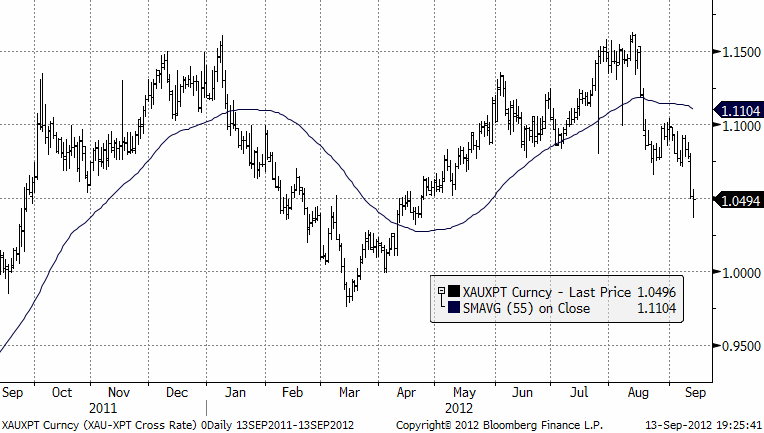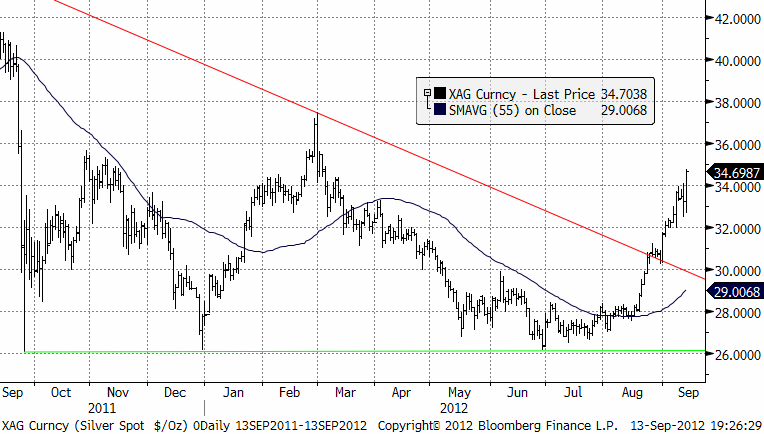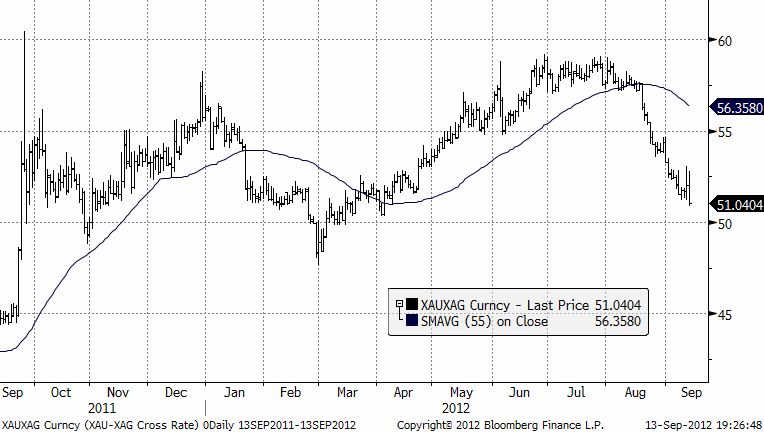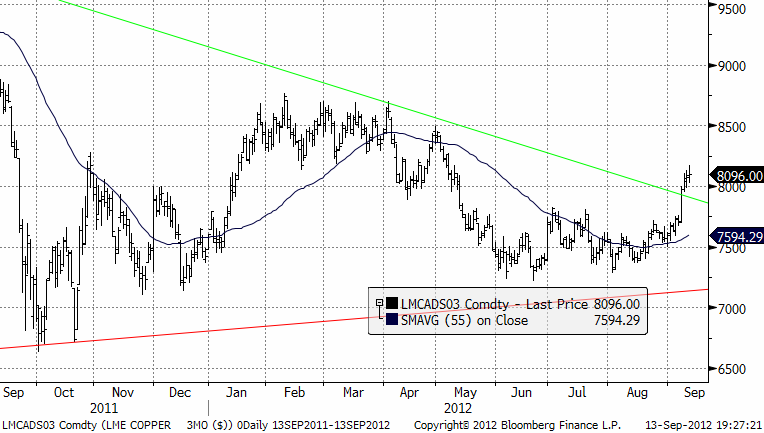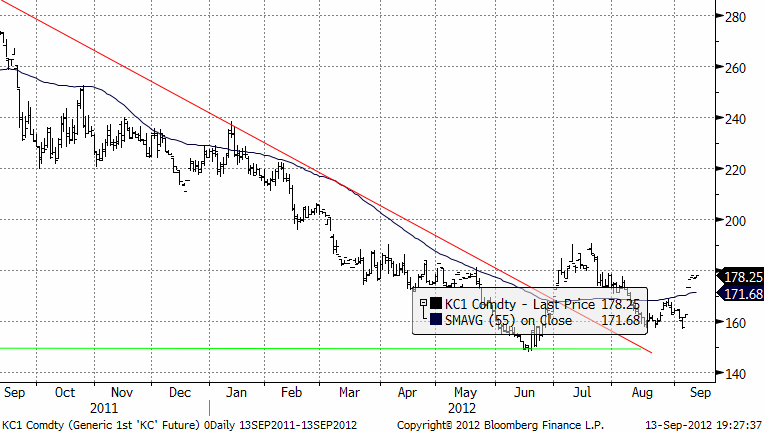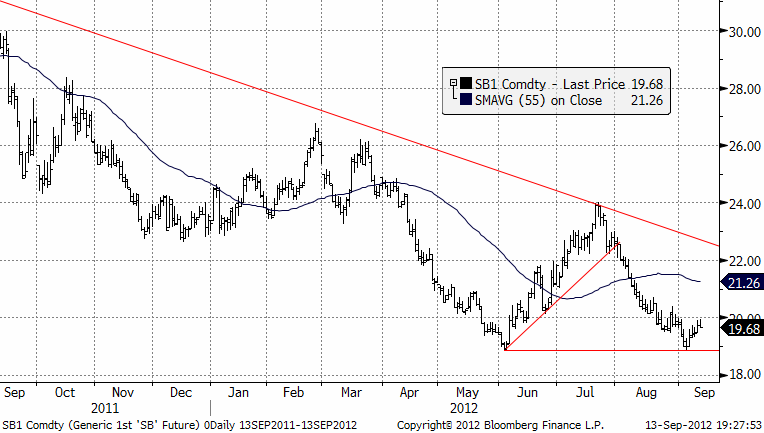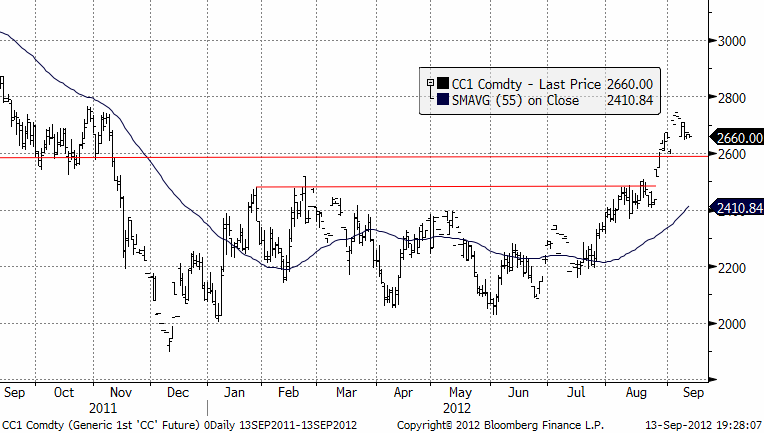Analys
SEB – Råvarukommentarer, 14 september 2012
Sammanfattning av rekommendationer
Förra veckans summerade vinst på 28% vändes den här veckan såsom mätt per stängning igår torsdag, till en förlust. Dock skulle det ha sett annorlunda ut om man beräknade vinsten idag, eftersom FED:s besked igår kväll ledde till kursrusning i ädelmetallerna. FED annonserade en öppen Quantitative Easing (QE3), där man ska köpa amerikanska bostadsobligationer för 40 miljarder dollar varje månad till dess sysselsättningen förbättras. FED fortsätter också ”Operation Twist” och behåller räntorna mellan noll och 0.25%. Man lovade att hålla räntorna i botten fram till slutet av 2014. En journalist för the New York Times beskrev den här oväntade aggressiviteten så här: ”We will provide the punch for the party. Heavy pours. And we’re not going to be too careful about closing time.”
Naturligtvis är detta mycket positivt för ädelmetaller. Men fundamentalt är efterfrågan på råvaror alltjämt svag. Det betyder att koppar, olja, elektricitet och annat som efterfrågas när industrin går på högvarv kanske omotiverat har stigit i pris. Sedelpressen skapar inte tillväxt och välstånd.
Råolja – Brent
Trots QE3 har råoljepriset svårt att gå över 117 dollar, där det finns ett tekniskt motstånd. Vi förväntar oss ett svagare oljepris in i det fjärde kvartalet, men Iran-problematiken hänger i bakgrunden som ett olöst problem. Orkansäsongen i Mexikanska golfen och underhållsarbeten på Nordsjön, tillsammans med säsongsmässigt hög konsumtion har gett stöd till oljemarknaden. QE3 och det tyska godkännande av ESM ger också stöd. Men underliggande svag makroekonomisk statistik visar att efterfrågan är svag framöver i USA, Europa och Kina. Således tror vi att oljepriset kommer att falla tillbaka något från nuvarande nivå när vi ger oss in i det fjärde kvartalet.
Oljemarknaden är emellertid i en svår situation. Balansen mellan utbud och efterfrågan är svag. Reservkapaciteten är liten, pga sanktionerna mot Iran och det finns inga tecken på ett det ”phony war” är på väg att lösas. Snarare tvärt om. Iran fortsätter arbeta på sitt kärnenergiprogram. Man kan därför lätt tänka sig en ytterligare åtstramning av sanktionerna från EU och USAs sida. Israel har än så länge låtit Kfirerna stå på marken. Strategiska lager finns att lätta på om det skulle bli ännu hårdare restriktioner. Detta skulle kunna gjuta olja på varje prisuppgång.
Vi rekommenderar en kort position i oljemarknaden, om man inte föredrar att förhålla sig neutral. Alltså t ex BEAR OLJA X2 S.
Elektricitet
Vi har noterat att de flesta varit intresserade av att köpa BULL EL X4 S, medan vi här vidhållit att det är lite för tidigt att göra det. Vi tror att priset kommer att utveckla sig svagt under september och oktober, att marknaden söker en botten under den här perioden. Ett pris under 40 euro per MWh är köpvärt. Nu är 40 euro ett tekniskt stöd, så det är möjligt att 40 euro är botten. Mellan 40 och 41 euro kan det vara köptillfälle, men annars bör man vara försiktig med BULL.
Guld, Silver och Platina
Allt har talat för ädelmetallerna den här veckan: Löften om monetära stimulanser på båda sidor om Atlanten. Tekniskt sett ser det mycket starkt ut. Guld är upp 4 %, silver och platina ca 6 % sedan förra fredagen. Vi deklarerade förra veckan att ädelmetallerna hade mer att ge. Målkurserna som vi angav börjar närma sig och det kan vara idé att börja ta hem vinster. $1800 för guld och $35 för silver utgör motståndsnivåer. Platina kan vara undantaget där potentialen kan vara större med tanke på oroligheterna i Sydafrika som har eskalerat i veckan. Uppror och strejker har spridits till fler gruvor, och flera bedömare varnar för kaos i hela landet. Det är i och för sig inte bra för utbudet på guld heller, även om Sydafrika för längesedan lämnade förstaplatsen som producentland.
Vår favorit är Platina (t ex genom certifikatet PLATINA S, eller för den som vill ha lite mer hävstång, BULL PLATIN X4 S). Nedan ser vi platinaprisets utveckling, där brottet av den långsiktiga motståndslinjen, signalerade att den långa konsolideringsperioden är bruten, på uppsidan. Det ser ut som om 1700, toppen från februiari/mars, kan bli ett motstånd. Det är sent i den raska uppgångsfasen och det är väl inte otroligt att det kommer lite eftertankens kranka blekhet här. Med vägen stadigt inslagen på helikopterpengar i världe borde dock priset på ädelmetaller som t ex platina kunna inflateras mer.
Nedan ser vi priset på guld dividerat med priset på platina. Vi ser att guld har utvecklats sämre än platina sedan mitten av augusti. Tekniskt ser den här trenden stark ut och har potential att gå från 1.05 till 1, dvs en outperformance på ytterligare 5% till platinas fördel. Det mesta av rörelsen från 1.15 är dock avklarad och platina har inte lång tid kvar att vara vår favorit bland ädelmetallerna.
Nedan ser vi silverprisets kursutveckling. Det är samma starka tekniska köpsignal i den här metallen.
Även i den här jämförelsen med silver, ser vi att guld har utvecklats sämre än silver sedan månadsskiftet juli/augusti. Vi ser att det finns en stödnivå kring 50 i kvot mellan guld och silverpris. Silverprisets uppgång i förhållande till guld är nära den nivå och vi rör oss alltså in i stödområdet. Det mesta av silvrets outperformance i förhållande till guld är avklarat.
Koppar
Förra veckans svaga arbetsmarknadsstatistik blev (paradoxalt nog) startskottet för ett nytt rally för både bas- och ädelmetaller. Det var en ”tillräckligt” svag siffra som skulle behövas för att få FED att agera. Helgens nyhet att Kina beslutat om ett infrastrukturpaket inkluderande järnvägs- och tunnelbanebyggen motsvarande 157 Mdr USD, blev nästa impuls. Förväntningarna var således högt ställda, och FED:s besked nu ikväll (torsdag) om ett nytt penningpolitiskt stimulanspaket, har därför ännu inte gett någon större effekt. Prisuppgångarna sedan förra fredagen ligger mellan 5 och 10 % för de stora basmetallerna. Aluminium sticker ut med en uppgång på hela 10 %.
I skrivandes stund ligger kopparpriset på LME kring $8180 ($3,72/Lbs) vilket är upp ca 5 % från förra fredagen. Marknaden har nu (med besked) brutit igenom motståndet. Stimulanspaketen från Kina, Europa och USA har naturligtvis gjort sitt för att stärka stämningsläget. Frågan är hur det ser ut fundamentalt. Det bör påpekas att Kina som förbrukar ca 40 % av all koppar befinner sig i en avmattning. Det gäller att stimulanserna får effekt för att prisnivåerna ska hålla. Det är svårbedömt. Aktörerna räknar med fler åtgärder från den kinesiska ledningen. Frågan är till vilka sektorer stimulanserna riktas. Utbyggnaden av elnätet betyder mest (för koppar). Lagernivåerna är höga, vissa marknadsbedömare uppskattar den totala nivån till hela 1,8 milj. ton (det produceras ca 18-19 milj. ton globalt). Statistiken i Kina är osäker. Om det stämmer är det väldigt stora lager, men kom ihåg att Kina kommer att behöva metallen förr eller senare. Just nu är mycket av ett positivt scenario inprisat. Risken har ökat för en rekyl.
Vi väljer att vara neutrala till koppar till nästa veckobrev.
Kaffe
Priset på Arabica, som handlas i New York, som steg pga regnen i viktiga kaffeodlingsormråden i Brasilien i juni och juli, föll sedan tillbaka i augusti.
Colombia, som är världens näst största producent av arabica, tycks vara på väg mot en mindre skörd än väntat. Colombia behöver skörda 3.6 miljoner säckar (à 60 kg) från och med nu till årsskiftet, eller 34% mer än samma period förra året, för att nå upp till 8.5 miljoner säckar. Det är vad Colombias ”National Federation of Coffee Growers” förutspådde den 10 september.
Tekniskt verkar priset röra sig ”sidledes” och vi avvaktar ett eventuellt köp lite längre fram.
Socker
Priset på socker, tycks ha funnit ett stöd. Priset vände upp på samma nivå som i juni. Det skulle inte förvåna om priset nu steg upp mot motståndslinjen, dvs till 21 – 22 cent per pund, ur teknisk synvinkel.
Regnväder har återvänt till Brasiliens sockerrörsproducerande områden. Somar Meteorologia i Sao Paulo kommenterar att fälten kan vara för blöta för att skörda mot slutet av oktober. Branschföreningen Unica rapporterar produktionsdata varannan vecka. I Sud-Oeste (Center South i engelsk betydelse), där delstaten Sao Paulo ligger, hade branschen processat 9.4% mindre sockerrör än förra året fram till slutet av augusti. Augusti låg dock högre än förra året, då man tog igen vad man missat tidigare. Augusti låg 14.2% över förra årets augusti. Risken är nu alltså att regnen åter gör det svårt att skörda, vilket bör ge stöd för priset på socker.
I Indien, världens näst största producent av socker, har monsunen, som står för 70% av nederbörden i landet, fortsatt att förbättras. Från att under sommaren ha legat ca 30% sämre, ligger nederbörden sedan den 1 juni nu bara 9% under genomsnittet för de senaste 50 åren.
Vi stänger positionen i SHORT SOCKE A S. Och så ser vi vad som händer, om det kan utveckla sig ett köptillfälle istället.
Kakao
Förra veckan rekommenderade vi köp av KAKAO S. Det har varit torrt i Elfenbenskusten i juni och juli och det har påverkat utvecklingen av kakaoskörden negativt. De senaste dagarna har nederbörden återvänt och det har ökat förhoppningarna om skörden. Följaktligen har priset backat de senaste dagarna. Det rapporteras att chokladfabrikanterna avvaktade med köp när priset låg över 2700 dollar och väntade på en rekyl. Vi har nu den rekylen och det kan vara ett köptillfälle just nu.
För spannmål och övriga jordbruksprodukter hänvisas till gårdagens nyhetsbrev.
[box]SEB Veckobrev Veckans råvarukommentar är producerat av SEB Merchant Banking och publiceras i samarbete och med tillstånd på Råvarumarknaden.se[/box]
Disclaimer
The information in this document has been compiled by SEB Merchant Banking, a division within Skandinaviska Enskilda Banken AB (publ) (“SEB”).
Opinions contained in this report represent the bank’s present opinion only and are subject to change without notice. All information contained in this report has been compiled in good faith from sources believed to be reliable. However, no representation or warranty, expressed or implied, is made with respect to the completeness or accuracy of its contents and the information is not to be relied upon as authoritative. Anyone considering taking actions based upon the content of this document is urged to base his or her investment decisions upon such investigations as he or she deems necessary. This document is being provided as information only, and no specific actions are being solicited as a result of it; to the extent permitted by law, no liability whatsoever is accepted for any direct or consequential loss arising from use of this document or its contents.
About SEB
SEB is a public company incorporated in Stockholm, Sweden, with limited liability. It is a participant at major Nordic and other European Regulated Markets and Multilateral Trading Facilities (as well as some non-European equivalent markets) for trading in financial instruments, such as markets operated by NASDAQ OMX, NYSE Euronext, London Stock Exchange, Deutsche Börse, Swiss Exchanges, Turquoise and Chi-X. SEB is authorized and regulated by Finansinspektionen in Sweden; it is authorized and subject to limited regulation by the Financial Services Authority for the conduct of designated investment business in the UK, and is subject to the provisions of relevant regulators in all other jurisdictions where SEB conducts operations. SEB Merchant Banking. All rights reserved.
Analys
Tightening fundamentals – bullish inventories from DOE

The latest weekly report from the US DOE showed a substantial drawdown across key petroleum categories, adding more upside potential to the fundamental picture.

Commercial crude inventories (excl. SPR) fell by 5.8 million barrels, bringing total inventories down to 415.1 million barrels. Now sitting 11% below the five-year seasonal norm and placed in the lowest 2015-2022 range (see picture below).
Product inventories also tightened further last week. Gasoline inventories declined by 2.1 million barrels, with reductions seen in both finished gasoline and blending components. Current gasoline levels are about 3% below the five-year average for this time of year.
Among products, the most notable move came in diesel, where inventories dropped by almost 4.1 million barrels, deepening the deficit to around 20% below seasonal norms – continuing to underscore the persistent supply tightness in diesel markets.
The only area of inventory growth was in propane/propylene, which posted a significant 5.1-million-barrel build and now stands 9% above the five-year average.
Total commercial petroleum inventories (crude plus refined products) declined by 4.2 million barrels on the week, reinforcing the overall tightening of US crude and products.


Analys
Bombs to ”ceasefire” in hours – Brent below $70

A classic case of “buy the rumor, sell the news” played out in oil markets, as Brent crude has dropped sharply – down nearly USD 10 per barrel since yesterday evening – following Iran’s retaliatory strike on a U.S. air base in Qatar. The immediate reaction was: “That was it?” The strike followed a carefully calibrated, non-escalatory playbook, avoiding direct threats to energy infrastructure or disruption of shipping through the Strait of Hormuz – thus calming worst-case fears.

After Monday morning’s sharp spike to USD 81.4 per barrel, triggered by the U.S. bombing of Iranian nuclear facilities, oil prices drifted sideways in anticipation of a potential Iranian response. That response came with advance warning and caused limited physical damage. Early this morning, both the U.S. President and Iranian state media announced a ceasefire, effectively placing a lid on the immediate conflict risk – at least for now.
As a result, Brent crude has now fallen by a total of USD 12 from Monday’s peak, currently trading around USD 69 per barrel.
Looking beyond geopolitics, the market will now shift its focus to the upcoming OPEC+ meeting in early July. Saudi Arabia’s decision to increase output earlier this year – despite falling prices – has drawn renewed attention considering recent developments. Some suggest this was a response to U.S. pressure to offset potential Iranian supply losses.
However, consensus is that the move was driven more by internal OPEC+ dynamics. After years of curbing production to support prices, Riyadh had grown frustrated with quota-busting by several members (notably Kazakhstan). With Saudi Arabia cutting up to 2 million barrels per day – roughly 2% of global supply – returns were diminishing, and the risk of losing market share was rising. The production increase is widely seen as an effort to reassert leadership and restore discipline within the group.
That said, the FT recently stated that, the Saudis remain wary of past missteps. In 2018, Riyadh ramped up output at Trump’s request ahead of Iran sanctions, only to see prices collapse when the U.S. granted broad waivers – triggering oversupply. Officials have reportedly made it clear they don’t intend to repeat that mistake.
The recent visit by President Trump to Saudi Arabia, which included agreements on AI, defense, and nuclear cooperation, suggests a broader strategic alignment. This has fueled speculation about a quiet “pump-for-politics” deal behind recent production moves.
Looking ahead, oil prices have now retraced the entire rally sparked by the June 13 Israel–Iran escalation. This retreat provides more political and policy space for both the U.S. and Saudi Arabia. Specifically, it makes it easier for Riyadh to scale back its three recent production hikes of 411,000 barrels each, potentially returning to more moderate increases of 137,000 barrels for August and September.
In short: with no major loss of Iranian supply to the market, OPEC+ – led by Saudi Arabia – no longer needs to compensate for a disruption that hasn’t materialized, especially not to please the U.S. at the cost of its own market strategy. As the Saudis themselves have signaled, they are unlikely to repeat previous mistakes.
Conclusion: With Brent now in the high USD 60s, buying oil looks fundamentally justified. The geopolitical premium has deflated, but tensions between Israel and Iran remain unresolved – and the risk of missteps and renewed escalation still lingers. In fact, even this morning, reports have emerged of renewed missile fire despite the declared “truce.” The path forward may be calmer – but it is far from stable.
Analys
A muted price reaction. Market looks relaxed, but it is still on edge waiting for what Iran will do

Brent crossed the 80-line this morning but quickly fell back assigning limited probability for Iran choosing to close the Strait of Hormuz. Brent traded in a range of USD 70.56 – 79.04/b last week as the market fluctuated between ”Iran wants a deal” and ”US is about to attack Iran”. At the end of the week though, Donald Trump managed to convince markets (and probably also Iran) that he would make a decision within two weeks. I.e. no imminent attack. Previously when when he has talked about ”making a decision within two weeks” he has often ended up doing nothing in the end. The oil market relaxed as a result and the week ended at USD 77.01/b which is just USD 6/b above the year to date average of USD 71/b.

Brent jumped to USD 81.4/b this morning, the highest since mid-January, but then quickly fell back to a current price of USD 78.2/b which is only up 1.5% versus the close on Friday. As such the market is pricing a fairly low probability that Iran will actually close the Strait of Hormuz. Probably because it will hurt Iranian oil exports as well as the global oil market.
It was however all smoke and mirrors. Deception. The US attacked Iran on Saturday. The attack involved 125 warplanes, submarines and surface warships and 14 bunker buster bombs were dropped on Iranian nuclear sites including Fordow, Natanz and Isfahan. In response the Iranian Parliament voted in support of closing the Strait of Hormuz where some 17 mb of crude and products is transported to the global market every day plus significant volumes of LNG. This is however merely an advise to the Supreme leader Ayatollah Ali Khamenei and the Supreme National Security Council which sits with the final and actual decision.
No supply of oil is lost yet. It is about the risk of Iran closing the Strait of Hormuz or not. So far not a single drop of oil supply has been lost to the global market. The price at the moment is all about the assessed risk of loss of supply. Will Iran choose to choke of the Strait of Hormuz or not? That is the big question. It would be painful for US consumers, for Donald Trump’s voter base, for the global economy but also for Iran and its population which relies on oil exports and income from selling oil out of that Strait as well. As such it is not a no-brainer choice for Iran to close the Strait for oil exports. And looking at the il price this morning it is clear that the oil market doesn’t assign a very high probability of it happening. It is however probably well within the capability of Iran to close the Strait off with rockets, mines, air-drones and possibly sea-drones. Just look at how Ukraine has been able to control and damage the Russian Black Sea fleet.
What to do about the highly enriched uranium which has gone missing? While the US and Israel can celebrate their destruction of Iranian nuclear facilities they are also scratching their heads over what to do with the lost Iranian nuclear material. Iran had 408 kg of highly enriched uranium (IAEA). Almost weapons grade. Enough for some 10 nuclear warheads. It seems to have been transported out of Fordow before the attack this weekend.
The market is still on edge. USD 80-something/b seems sensible while we wait. The oil market reaction to this weekend’s events is very muted so far. The market is still on edge awaiting what Iran will do. Because Iran will do something. But what and when? An oil price of 80-something seems like a sensible level until something do happen.
-

 Nyheter3 veckor sedan
Nyheter3 veckor sedanStor uppsida i Lappland Guldprospekterings aktie enligt analys
-

 Nyheter4 veckor sedan
Nyheter4 veckor sedanBrookfield ska bygga ett AI-datacenter på hela 750 MW i Strängnäs
-

 Nyheter3 veckor sedan
Nyheter3 veckor sedanSilverpriset släpar efter guldets utveckling, har mer uppsida
-

 Nyheter4 veckor sedan
Nyheter4 veckor sedanTradingfirman XTX Markets bygger datacenter i finska Kajana för 1 miljard euro
-

 Nyheter2 veckor sedan
Nyheter2 veckor sedanUppgången i oljepriset planade ut under helgen
-

 Nyheter2 veckor sedan
Nyheter2 veckor sedanLåga elpriser i sommar – men mellersta Sverige får en ökning
-

 Analys2 veckor sedan
Analys2 veckor sedanVery relaxed at USD 75/b. Risk barometer will likely fluctuate to higher levels with Brent into the 80ies or higher coming 2-3 weeks
-

 Nyheter1 vecka sedan
Nyheter1 vecka sedanMahvie Minerals växlar spår – satsar fullt ut på guld



